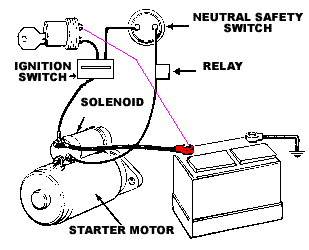Starting System > Starter Testing
How to test your car starter

- Make sure the battery is fully charged and that the battery terminal connections are clean and tight.
- Check the starter motor wiring for damage and/or open and shorted wires.
- Check that all starter motor electrical connections are clean and tight.
- If the starter motor cranks slowly and the solenoid clicks or chatters, test the starter motor as follows:
A.Turn the ignition key to the start position.
B.Use a Digital Volt Ohm Meter (DVOM) set to read voltage. Measure the cranking voltage at the battery terminal posts.
C.If the voltage is less than 9.6 volts check the battery.
D.If the battery voltage is 9.6 volts or more continue with the test.
E.Connect the negative lead of the DVOM to the battery negative terminal and the positive lead of the DVOM to the engine block.
- If the voltage is less than 0.5 volts, attach the positive lead of the DVOM to the starter B terminal and crank the engine.
- If the voltage reading is less than 9.0 volts, replace the starter motor.
- If the starter motor does not crank and there is no sound from the solenoid, test the starter motor as follows:
A. Turn the headlights and the dome light on.
B. Turn the ignition key to the START position.
C .If the lights stay bright, turn the radio, heater and turn signals on.
D. If the accessories you have turned on do not operate properly, check the bulkhead connector fusible link and the ignition switch connections.
E .If the accessories operate properly, continue with the test.
F .Make sure the ignition key is still in the START position.
G. If your vehicle is equipped with a automatic transmission, using a Digital Volt Ohm Meter (DVOM) set to read voltage, connect the negative lead of the DVOM to the battery negative terminal and the positive lead of the DVOM to the starter S terminal.
H .If the voltage is 9.6 volts or more, replace the starter motor.
I. If the voltage is 9.6 volts or less, attach the positive lead of the DVOM to the ignition switch solenoid terminal.
J. If the voltage is 9.6 volts or more, repair the purple wire from the ignition switch to the starter.
K. If the voltage is less than 9.6 volts, replace the ignition switch.
L. If your vehicle is equipped with a manual transmission, using a Digital Volt Ohm Meter (DVOM) set to read voltage, connect the negative lead of the DVOM to a good known ground and the positive lead of the DVOM to the neutral/start switch. Turn the ignition key to the START position and depress the clutch.
M. If there is more than 9.6 volts present at one terminal, test the switch connector and adjustment. If the adjustment and connector are functioning properly, replace the switch.
N. If there is less than 9.6 volts present at both terminals, make sure the ignition key is still in the START position.
O. Test the voltage at the ignition switch solenoid terminal.
P. If the voltage is 9.6 volts or more, repair the yellow feed wire from the ignition switch.
Q. If the voltage is less than 9.6 volts, replace the ignition switch.
GET AN ONLINE AUTO REPAIR MANUAL FOR YOUR CAR - Get on-line access to drive belt routing, repair instructions, wiring diagrams, trouble code diagnostic charts and updated factory bulletins.

Top Categories
Serpentine Belt Routing Diagrams
Ask a Mechanic
Free Insurance Quotes
Car Owners Manuals
Auto Wiring Diagrams
Auto Repair Manuals
Auto Repair Estimates
Hybrid Cars
Nut & Bolt Measuring Charts
Mechanic's Lien Form
Ask a Mechanic
Free Insurance Quotes
Car Owners Manuals
Auto Wiring Diagrams
Auto Repair Manuals
Auto Repair Estimates
Hybrid Cars
Nut & Bolt Measuring Charts
Mechanic's Lien Form






